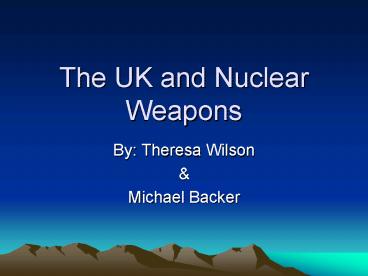The UK and Nuclear Weapons - PowerPoint PPT Presentation
1 / 17
Title:
The UK and Nuclear Weapons
Description:
The UK and Nuclear Weapons. By: Theresa Wilson. Michael Backer. History. Originally, the UK had been conducting its own research program from 1940 but ... – PowerPoint PPT presentation
Number of Views:50
Avg rating:3.0/5.0
Title: The UK and Nuclear Weapons
1
The UK and Nuclear Weapons
- By Theresa Wilson
- Michael Backer
2
History
- Originally, the UK had been conducting its own
research program from 1940 but then combined with
the US program three years later. When this
partnership ended another three years later in
August 1946 because of the McMahon Act, where US
controlled and managed nuclear technology, UK
decided to return to its own development program
and testing. In 1952 they finally tested their
first bomb, Hurricane.
3
Nuclear Weapons States
- Nuclear Non-Proliferation Treaty a treaty to
limit the spread of nuclear weapons among the
world.
- Only States with weapons
- 1. US
- 2. Russia
- 3. UK
- 4. France
- 5. China
4
The First Testings
- The United Kingdom was the third state to test an
independently developed nuclear weapon in October
1952 (Hurricane).
- The two before were US in 1945 with Trinity and
the Soviet Union in 1949 with RDS-1.
5
UK Testing
- 1st Test
- Hurricane
- October 3, 1952
- 25 kT
- Last Test
- Julin Bristol
- November 26, 1991
- Largest Test
- April 28, 1958
- 3 Mt
6
Motivation
- UKs military was convinced by the need to have
an atomic capability to match any other power
which might develop such weapons. - In august 1946, the Chief of the Air Staff put in
a demand through normal procurement channels for
an atomic bomb and Hurricane was the result in
1952.
7
- After Hurricanes testing, the Chief argued that
more reliance should be placed on nuclear threats
to contain Soviet expansion. - UK was the first country to base its national
defense upon a declared policy of nuclear
deterrence.
8
Partial Test Ban Treaty
- prohibits all tests of nuclear weapons except
underground. - developed both to slow the arms race (nuclear
testing was, back then, necessary for continued
nuclear weapon advancements), and to stop the
excessive release of nuclear fallout into the
planet's atmosphere.
9
- The UK government signed this treaty on August 5
1963, along with the United States and the Soviet
Union. - Again, it restricted it to underground nuclear
tests by outlawing testing in the atmosphere,
underwater, or in outer space.
10
Total
- The UK has conducted 45 tests total.
- 21 performed in Australian territory
- 9 in mainland South Australia at Maralinga and
Emu Field
- The 23 or 24 test from December 1962, onward,
were in conjunction with the US at their Nevada
site. - This included Julin Bristol.
11
(No Transcript)
12
More recently
- A new Trident strategic missile system became
operational in 1994, building four submarines. - By 1998, these represented the only nuclear
systems fielded by the UK, and were limited to 48
warheads each. - The motivation for this force appears to be as an
insurance policy against an uncertain future.
13
Today
- UK are thought to have a weapons stockpile of
around 200 operational nuclear warheads, much
less than their previous numbers of around 350
during the 1970s. - The low number of testing taken by the UK is
misleading. Because they have access to US
testing data, eliminating their need to test as
much.
14
Fun Fact (Number of Warheads)
- The UK government stated that once the Vanguard
submarines became fully operational, that last
would maintain a stockpile of fewer than 200
operationally available warheads. - The fourth and final one, Vengeance, entered
service on November 27, 1999.
15
Fun Fact
- Since the 1958 US-UK Mutual Defense Agreement,
both countries have cooperated extensively on
nuclear security matters. It has involved the
exchange of classified scientific knowledge and
nuclear materials such as plutonium.
16
Fun Fact
- During the cold war, government effort made to
assess the effects of a nuclear attack on the UK
was significant. A major government exercise,
Square Leg, was held in September 1980 and
involved around 130 warheads with a total yield
of 200 megatons. They say that this is probably
the largest attack that a country could survive
in some limited form.
17
Works Cited
- http//en.wikipedia.org/wiki/Nuclear_weapons_and_t
he_United_Kingdom - http//www.tgarden.demon.co.uk/writings/articles/2
001/010301nuc.html - http//images.google.com/imgres?imgurlhttp//cont
ent.answers.com/main/content/wp/en/2/27/Worldwide_
nuclear_testing.pngimgrefurlhttp//www.answers.c
om/topic/nuclear-testing - http//en.wikipedia.org/wiki/Partial_Test_Ban_Trea
ty































